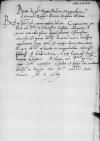List #2764
Bona Sforza do Ioannes DANTISCUSBrest-Litovsk, 1544-10-11
| odebrano Wormditt (Orneta), 1544-10-21 Rękopiśmienne podstawy źródłowe:
| ||||
Tekst + aparat krytyczny + komentarz Zwykły tekst Tekst + komentarz Tekst + aparat krytyczny
Reverendo in Christo Patri, domino
Reverende in Christo Pater, sincere nobis dilecte.
Cognovimus ex litteris Vestrae Paternitatis et
Ac salva et felix diu valeat.
Dat(ae) or Dat(um)⌈Dat(ae)Dat(ae) or Dat(um)⌉
in


 BCz, 1601, p. 740
BCz, 1601, p. 740